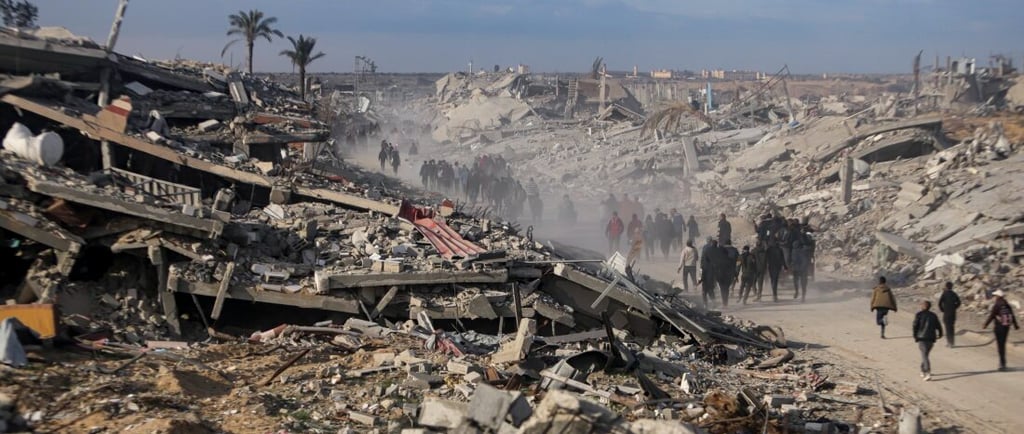Gaza: A Ceasefire on Paper, but What Comes Next for Israel and Palestine?
A ceasefire has been reached in Gaza, but its longevity remains uncertain. As regional powers adjust to the shift, the fragile peace could have far-reaching consequences beyond the battlefield. Will this truce lead to lasting stability, or is the region on the brink of renewed conflict?
ISRAELPALESTINE
Ekaterina Romanenko
2/8/20256 min read


After months of fighting and prolonged negotiations led by the US, Qatar, and Egypt, a ceasefire has finally taken effect in Gaza. It was announced on January 15 and implemented four days later. The agreement is based on a proposal originally put forward by former US President Joe Biden in May 2024 and follows a phased de-escalation plan.
The first phase, lasting 42 days, includes a full ceasefire. During this period, Hamas is expected to release 33 hostages—women, children, the elderly, and the sick—while Israel, in return, will release around 1,900 Palestinian prisoners. Israeli forces will also withdraw from populated areas, allowing displaced civilians to return home. Meanwhile, Gaza will receive 600 aid trucks daily, including 50 carrying fuel. This is a significant increase from December 2024, when the UN recorded an average of just 90 trucks per day.
However, while the agreement offers a temporary reprieve, historical precedents suggest that its long-term viability remains uncertain.
Looking at historical parallels, it becomes evident that ceasefires between Israel and Palestinian factions have rarely translated into lasting peace. The 1949 armistice agreements ended the first Arab-Israeli war but failed to resolve the fundamental grievances that would fuel future conflicts. The Oslo Accords in the 1990s promised a path toward Palestinian self-determination but ultimately disintegrated, leading to the Second Intifada. More recent ceasefires in Gaza—whether after the 2008-09 war, the 2012 operation, or the 2014 conflict—have all followed the same trajectory: international pressure secures a temporary halt in hostilities, only for violence to erupt again due to the absence of a comprehensive political solution. The 2025 ceasefire, coming after an unprecedented year-long war, is unique in its scale and the geopolitical shifts it has triggered, but its survival will depend on more than just diplomatic agreements.
For Israel, the ceasefire is a double-edged sword. On one hand, it provides a necessary military pause after prolonged operations that strained resources and public morale. The conflict has taken a toll on Israel’s economy, particularly in sectors reliant on foreign investment and stability. On the other hand, the ceasefire does not resolve Israel’s primary security concerns. Hardliners within the government view any truce as a concession to Hamas, fearing that the group will use the lull to rearm and fortify its position. Israel’s leadership faces internal pressures from both the political right, which demands a more aggressive strategy, and the broader public, which is divided between those exhausted by war and those who believe that unfinished military objectives will lead to another round of violence. The Israeli security establishment remains wary of whether Hamas and other militant factions will genuinely adhere to the ceasefire or merely regroup for future confrontations.
For Palestinians, the situation is equally precarious. The ceasefire provides an immediate humanitarian reprieve, but it does not resolve the deep divisions between Hamas in Gaza and the Palestinian Authority in the West Bank. The war has further fragmented Palestinian leadership, with Hamas seeking to consolidate its influence while the Palestinian Authority struggles to maintain legitimacy.
In Gaza, nearly 2.3 million people have been forced from their homes by Israeli strikes and evacuation orders. Now, as hundreds of thousands return, they face a harsh reality: entire neighborhoods have been reduced to rubble, with 60% to 70% of buildings damaged or destroyed. Rebuilding Gaza will take years and cost billions.
Palestinian public sentiment has also shifted—while there is widespread frustration with Israeli policies, there is also growing disillusionment with Hamas and its ability to secure lasting gains. Many in Gaza fear that, as with previous ceasefires, international promises of aid and reconstruction will remain unfulfilled, leaving the territory trapped in a cycle of devastation and fragile truces.
The ceasefire’s impact extends beyond Israel and Palestine, affecting regional actors with vested interests in the conflict’s outcome. Egypt, as a key mediator, has played a central role in brokering past truces and continues to leverage its position as a stabilizing force. However, Cairo also faces domestic security concerns, particularly in the Sinai Peninsula, where militant groups have exploited instability in Gaza to expand their operations. A lasting ceasefire would benefit Egypt economically, particularly through enhanced trade and cooperation with Israel, but Egyptian leaders remain skeptical of long-term stability.
Jordan, home to a significant Palestinian population, faces its own internal challenges. Public opinion in Amman has been overwhelmingly sympathetic to the Palestinian cause, putting pressure on the Jordanian monarchy to take a more assertive stance against Israel. While the ceasefire may temporarily ease tensions, it does not address the broader frustrations that have fueled anti-Israel sentiment within Jordan. The government must navigate between maintaining its strategic ties with Israel and addressing domestic unrest driven by anger over the conflict.
Iran, a long-time supporter of Hamas and other militant groups, views the ceasefire as an opportunity to recalibrate its strategy. While Tehran publicly backs Palestinian resistance, its broader objective is to maintain pressure on Israel without provoking a direct regional war. The ceasefire allows Iran to continue its asymmetric approach—supporting proxy groups while avoiding full-scale confrontation. However, should the truce collapse, Iran may find itself under renewed scrutiny, particularly from Gulf states that seek to distance themselves from prolonged instability.
The Gulf states, particularly Saudi Arabia and the UAE, have taken a more pragmatic approach. Their primary focus is economic growth and regional stability, making prolonged conflict in Gaza an unwelcome distraction. While they have condemned Israeli actions and expressed support for Palestinian rights, their long-term priorities lie in securing investment, advancing technological cooperation, and maintaining diplomatic normalization efforts with Israel. A sustained ceasefire aligns with their strategic goals, but renewed violence could complicate their regional ambitions, particularly as Saudi Arabia weighs formalizing ties with Israel.
Beyond the Middle East, the ceasefire’s impact on global markets is significant. The energy sector, in particular, remains sensitive to Middle Eastern instability. While Gaza itself is not an oil-producing region, the broader conflict dynamics influence investor sentiment. Any escalation involving Iran, Hezbollah, or other regional actors could disrupt oil flows, sending prices higher. The ceasefire provides short-term stability, but energy markets remain on edge, aware that tensions could flare up again.
Trade and logistics also face ripple effects from the conflict. The Suez Canal, a critical artery for global commerce, has seen increased security concerns due to the broader geopolitical climate. Shipping companies and insurers are closely monitoring the situation, as any renewed hostilities could lead to higher costs and logistical disruptions. A lasting truce would encourage investment in regional trade routes, while a breakdown in the ceasefire could heighten risks for businesses reliant on Middle Eastern supply chains.
The defense industry, meanwhile, continues to benefit from sustained regional tensions. Even in times of ceasefire, military spending in the Middle East remains high, with Israel, Saudi Arabia, and the UAE among the top defense purchasers. If the ceasefire holds, the focus may shift toward cybersecurity and border security investments; if it fails, demand for weapons systems, missile defense technology, and military hardware will surge once again.
For foreign investors, the ceasefire offers a moment of cautious optimism, particularly for Israel’s tech sector and Gulf economic projects. However, the region’s history of conflict-driven economic disruptions means that many investors remain wary. Capital flight is a persistent risk in times of instability, and renewed hostilities would likely trigger another wave of financial uncertainty. The longer the ceasefire holds, the more confidence will return to Middle Eastern markets, but sustained peace is far from guaranteed.
Political tensions in Washington and Jerusalem are adding another layer of uncertainty to the ceasefire. In a recent high-profile meeting, Israeli Prime Minister Benjamin Netanyahu called Donald Trump the “greatest friend” Israel has ever had in the White House. Trump, in turn, has been vocal about his own vision for Gaza. He has suggested that the U.S. could deploy troops to the region if needed and even floated the idea of relocating Palestinians elsewhere. His ultimate goal is to turn Gaza into a “Middle Eastern Riviera” that would attract global investors, possibly even placing it under U.S. administration once the conflict ends.
These ideas have sparked immediate backlash. Hamas and Fatah have condemned them, as have Arab leaders and international officials, warning that such drastic moves could destabilize the region even further. Critics argue that Trump’s proposals not only threaten Palestinian statehood but could also ignite another round of conflict.
Meanwhile, UN Secretary-General António Guterres continues to press for a full ceasefire and the release of all remaining hostages. He has also warned against any forced displacement of Palestinians, calling for a solution that ensures long-term stability.
The 2025 ceasefire, while a necessary step toward de-escalation, faces multiple threats: unresolved territorial disputes, shifting regional alliances, and the absence of a long-term diplomatic framework. From a geopolitical perspective, stability remains precarious. Any provocation—whether from Hamas, Israeli hardliners, or external actors like Iran—could reignite hostilities. Economically, global markets will remain sensitive to developments in the region, particularly in energy, trade, and investment.
Ultimately, the longevity of this ceasefire will depend on sustained diplomatic engagement, economic incentives for peace, and the willingness of both Israeli and Palestinian leadership to move beyond temporary truces toward a comprehensive resolution. Without these elements, history may once again repeat itself.


